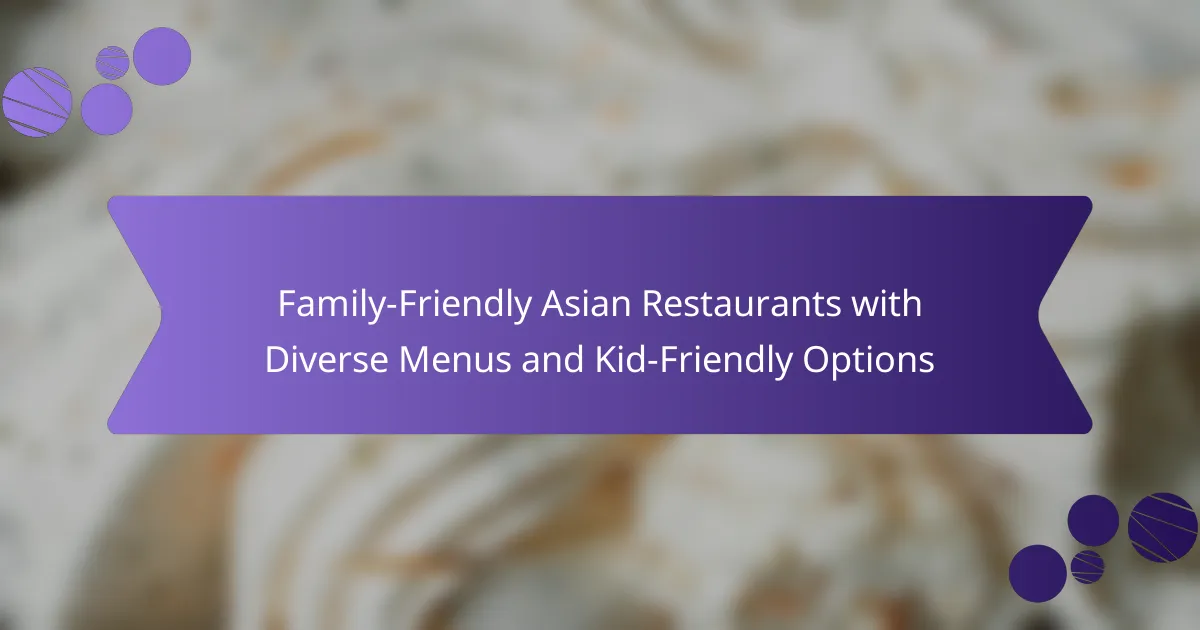
What are Family-Friendly Asian Restaurants?
Family-friendly Asian restaurants are dining establishments that cater to families with children. They typically offer diverse menus that include a variety of Asian cuisines. These restaurants often provide kid-friendly options such as smaller portion sizes or milder flavors. Many family-friendly Asian restaurants feature a welcoming atmosphere suitable for children. They may also include amenities like high chairs and children’s menus. Some establishments provide entertainment options, such as coloring sheets or games, to keep kids engaged. According to a survey by the National Restaurant Association, 70% of families prioritize kid-friendly options when dining out. This highlights the importance of catering to younger patrons.
How do Family-Friendly Asian Restaurants cater to families?
Family-friendly Asian restaurants cater to families by offering diverse menus and kid-friendly options. These establishments provide a variety of dishes that appeal to different tastes and dietary needs. Many restaurants include smaller portion sizes for children. They often feature milder flavors to accommodate younger palates. Family-friendly Asian restaurants frequently offer shared plates, encouraging communal dining. This setup fosters family interaction and engagement during meals. Additionally, these restaurants may provide high chairs and kid-friendly utensils. Some even have play areas or entertainment options to keep children occupied. Overall, the focus is on creating a welcoming environment for families.
What features make a restaurant family-friendly?
Family-friendly restaurants typically offer features that cater to families with children. These features include a kid-friendly menu with smaller portions and healthier options. High chairs and booster seats are essential for accommodating young children. Play areas or entertainment options, such as coloring books or games, help keep kids engaged. Staff trained in child-friendly service enhance the dining experience. Additionally, a welcoming atmosphere with noise control creates a comfortable environment for families. Research indicates that 70% of parents prioritize these features when choosing dining locations.
Why is the atmosphere important for families dining out?
The atmosphere is important for families dining out because it enhances the overall dining experience. A welcoming and comfortable environment encourages families to relax and enjoy their meal. Factors such as lighting, decor, and noise levels contribute to this atmosphere. For instance, soft lighting and vibrant decor can create a cheerful setting. Additionally, a family-friendly atmosphere often includes spaces for children to play or engage. Research shows that a positive dining atmosphere can lead to longer visits and increased satisfaction. This satisfaction is crucial for repeat business in restaurants catering to families.
What types of cuisines are offered in Family-Friendly Asian Restaurants?
Family-friendly Asian restaurants typically offer a variety of cuisines, including Chinese, Japanese, Thai, and Korean. Chinese cuisine features dishes like sweet and sour chicken and fried rice. Japanese options often include sushi, ramen, and tempura. Thai cuisine is known for its flavorful curries and pad Thai. Korean restaurants may serve barbecue, bibimbap, and kimchi. These cuisines cater to diverse tastes and often include kid-friendly options. Many Asian restaurants provide milder dishes to accommodate younger palates. They also offer family-sized portions for shared dining experiences.
How do different Asian cuisines appeal to children?
Different Asian cuisines appeal to children through their vibrant flavors and engaging presentations. Dishes often feature colorful ingredients that attract young diners. For instance, sushi rolls can be made with fun shapes and bright colors. Noodles are frequently served in playful forms, such as stir-fried or in soups. Many Asian cuisines include mild options that cater to children’s taste preferences. Additionally, the use of familiar ingredients, like chicken and rice, makes these cuisines accessible. Asian desserts often feature sweet flavors and interesting textures, appealing to children’s love for sweets. Family-friendly restaurants commonly offer smaller portions tailored for kids, enhancing their dining experience.
What unique dishes are commonly found on diverse menus?
Unique dishes commonly found on diverse menus include dim sum, sushi, and pho. Dim sum features a variety of small plates, often served in steamer baskets. Sushi is a Japanese dish consisting of vinegared rice paired with seafood or vegetables. Pho is a Vietnamese noodle soup with broth, rice noodles, and meat, typically beef or chicken. These dishes reflect the culinary diversity in Asian cuisine. They cater to different tastes and dietary preferences, making them popular in family-friendly restaurants. Each dish has distinct flavors and preparation methods. For example, dim sum can include dumplings, buns, and rolls, showcasing various cooking techniques. Sushi can be served as rolls, sashimi, or nigiri, allowing for customization. Pho is traditionally garnished with fresh herbs and lime, enhancing its taste.
How do Family-Friendly Asian Restaurants provide kid-friendly options?
Family-friendly Asian restaurants provide kid-friendly options by offering simplified menu items tailored for children. These options often include milder flavors to accommodate young palates. Many restaurants feature smaller portion sizes, making it easier for kids to enjoy their meals. Additionally, they may offer familiar dishes such as fried rice or chicken teriyaki, which appeal to children. Some establishments include fun presentations, like colorful sushi rolls or shaped dumplings, to engage kids visually. Many family-friendly restaurants also provide high chairs and booster seats to ensure comfort for young diners. Moreover, they often have a welcoming atmosphere that encourages families to dine together. This combination of tailored menus and family-oriented services makes dining enjoyable for both kids and parents.
What are some popular kid-friendly dishes in these restaurants?
Popular kid-friendly dishes in family-friendly Asian restaurants include chicken teriyaki, sushi rolls, and fried rice. Chicken teriyaki is often served with steamed vegetables and is a favorite among children. Sushi rolls, particularly those with cucumber or avocado, are typically well-received. Fried rice can be customized with various proteins, making it appealing to kids. Additionally, dumplings and spring rolls are commonly enjoyed as appetizers. These dishes are often designed to cater to younger palates while still providing a taste of Asian cuisine.
How do portion sizes accommodate children?
Portion sizes accommodate children by providing smaller servings tailored to their nutritional needs. Children typically require less food than adults due to their smaller stomachs and lower energy needs. Family-friendly Asian restaurants often offer kid-sized portions of popular dishes. This practice helps prevent food waste and encourages children to try new flavors. For instance, a standard [censured] meal may be reduced by 30-50% for a child’s portion. Research shows that appropriate portion sizes can promote healthier eating habits in children. Ensuring meals are visually appealing and appropriately sized can enhance children’s dining experiences.

What are the benefits of dining at Family-Friendly Asian Restaurants?
Dining at family-friendly Asian restaurants offers various benefits for families. These establishments typically provide diverse menus that cater to different tastes and dietary needs. Many Asian cuisines include vegetarian, vegan, and gluten-free options, making it easier for families with dietary restrictions to find suitable meals.
Additionally, family-friendly Asian restaurants often feature kid-friendly portions and flavors. This encourages children to try new foods in a welcoming environment. Such restaurants usually have a casual atmosphere, promoting a relaxed dining experience for families.
Moreover, many Asian restaurants include interactive dining options, such as hot pot or sushi-making, which can be enjoyable for families. Research shows that shared dining experiences can enhance family bonding. Overall, dining at these restaurants supports family interaction and exploration of diverse culinary traditions.
How do Family-Friendly Asian Restaurants enhance family bonding?
Family-friendly Asian restaurants enhance family bonding by providing a welcoming atmosphere and shared dining experiences. These restaurants often feature communal tables that encourage interaction among family members. The diverse menus cater to various tastes, allowing families to explore new flavors together. Kid-friendly options make dining enjoyable for children, fostering a positive experience. Sharing dishes promotes communication and cooperation during meals. Additionally, cultural elements, such as traditional dining customs, can create memorable experiences. Studies show that shared meals strengthen family relationships and improve communication skills. Thus, family-friendly Asian restaurants play a significant role in enhancing family bonding through these shared experiences.
What role does shared dining play in family interactions?
Shared dining enhances family interactions by fostering communication and connection. It creates an environment where family members can engage in meaningful conversations. Studies show that families who share meals regularly report stronger relationships. This practice encourages collaboration as members contribute to meal preparation and sharing. Shared dining also promotes cultural traditions and values, particularly in Asian families. It serves as a platform for storytelling and sharing experiences. Research indicates that shared meals can improve emotional well-being among family members. Overall, shared dining plays a crucial role in strengthening familial bonds.
How can dining out improve children’s culinary experiences?
Dining out can enhance children’s culinary experiences by exposing them to diverse flavors and cuisines. Children encounter new ingredients and cooking styles when dining at various restaurants. This exposure fosters curiosity about food and encourages them to try new dishes. Dining out also provides opportunities for social interaction. Children learn about different cultures through their culinary traditions. Additionally, restaurant dining can introduce children to the concept of portion sizes and meal presentation. Engaging with restaurant staff can further enhance their understanding of food preparation. Overall, dining out broadens children’s culinary horizons and enhances their appreciation for food.
Why is menu diversity important in Family-Friendly Asian Restaurants?
Menu diversity is important in family-friendly Asian restaurants because it caters to various tastes and dietary needs. A diverse menu ensures that children and adults can find options they enjoy. It helps accommodate different preferences, including vegetarian, gluten-free, and spicy choices. This inclusivity encourages families to dine together, enhancing their overall experience. Research shows that diverse menus can increase customer satisfaction and repeat visits. Families are more likely to return if everyone finds something appealing to eat. Therefore, menu diversity is essential for attracting and retaining families at Asian restaurants.
How does a diverse menu cater to different dietary preferences?
A diverse menu caters to different dietary preferences by offering a wide range of options. This includes vegetarian, vegan, gluten-free, and low-carb dishes. Such variety ensures that individuals with specific dietary needs can find suitable meals. For instance, a vegetarian can enjoy tofu stir-fry, while a gluten-free diner may opt for rice-based dishes. Additionally, diverse menus often include cultural dishes that appeal to various tastes. This approach enhances customer satisfaction and encourages repeat visits. Studies show that restaurants with diverse menus attract a broader customer base, catering to families with different dietary needs.
What impact does menu variety have on children’s willingness to try new foods?
Menu variety significantly increases children’s willingness to try new foods. Research indicates that exposure to a diverse range of food options encourages children to taste unfamiliar items. A study published in the journal “Appetite” found that children presented with multiple food choices were more likely to experiment with new flavors and textures. This suggests that variety can reduce food neophobia, which is the fear of trying new foods. Furthermore, children are more likely to engage with meals that offer different colors and presentations. Engaging menus stimulate curiosity and promote adventurous eating habits. These findings highlight the importance of diverse menus in family-friendly dining settings.

What should families look for when choosing a Family-Friendly Asian Restaurant?
Families should look for a welcoming atmosphere when choosing a family-friendly Asian restaurant. This includes comfortable seating and a layout that accommodates children. A diverse menu with options for various dietary preferences is essential. Restaurants should offer kid-friendly dishes that appeal to younger palates. Additionally, the availability of high chairs and booster seats enhances convenience for families. Engaging staff who are attentive to children’s needs can improve the dining experience. Cleanliness and safety measures are also crucial factors to consider. These elements contribute to a positive experience for families dining out.
How can families assess the kid-friendliness of a restaurant?
Families can assess the kid-friendliness of a restaurant by evaluating several key factors. They should check for a dedicated children’s menu with age-appropriate options. Availability of high chairs and booster seats is also important for younger children. Observing the restaurant’s atmosphere can provide insights; a casual and welcoming environment is often more suitable for families. Families can look for play areas or activities that engage children while waiting. Reviews from other families can be a reliable source of information about the restaurant’s kid-friendliness. Additionally, assessing the staff’s attitude towards children can indicate how accommodating the restaurant will be. These factors collectively help families determine if a restaurant is suitable for their kids.
What are key indicators of a restaurant’s family-oriented services?
Key indicators of a restaurant’s family-oriented services include a diverse menu catering to all ages. This often features kid-friendly options such as smaller portion sizes and familiar flavors. Availability of high chairs and booster seats indicates a family-friendly environment. Additionally, restaurants may provide play areas or activities for children, enhancing the dining experience for families. Friendly staff trained to accommodate families further supports this service orientation. Offering family meal deals or discounts can also signal a commitment to family-oriented services. Lastly, positive online reviews highlighting family experiences can serve as proof of a restaurant’s family-friendly reputation.
How important are reviews and ratings for family-friendly dining?
Reviews and ratings are crucial for family-friendly dining. They provide insights into the dining experience from other families. Parents often rely on these evaluations to ensure a safe and enjoyable environment for their children. Positive reviews can indicate kid-friendly menus, accommodating staff, and a welcoming atmosphere. According to a survey by BrightLocal, 84% of consumers trust online reviews as much as personal recommendations. This statistic highlights the influence of reviews on dining choices. Families are more likely to choose restaurants with high ratings and favorable feedback. Therefore, reviews and ratings significantly impact family-friendly dining decisions.
What practical tips can families use when visiting Family-Friendly Asian Restaurants?
Families can enhance their dining experience at family-friendly Asian restaurants by following practical tips. First, review the menu online beforehand to identify kid-friendly options. Many Asian restaurants offer dishes that appeal to children, such as dumplings or fried rice. Second, consider visiting during off-peak hours to avoid long waits. This can make the experience more enjoyable for families with young children. Third, ask for smaller portions or shareable plates. This approach allows kids to try various dishes without overwhelming them. Fourth, inquire about dietary restrictions or allergies. Many restaurants are accommodating and can adjust recipes accordingly. Fifth, engage children by allowing them to choose their own dishes. This can make them more excited about trying new foods. Finally, bring activities or games to keep children entertained while waiting for food. This helps maintain a pleasant atmosphere for everyone.
How can families prepare for a visit to ensure a positive experience?
Families can prepare for a visit to a family-friendly Asian restaurant by researching the menu in advance. This helps identify kid-friendly options that suit dietary preferences. Additionally, making a reservation can reduce wait times, ensuring a smoother experience. Arriving early allows families to settle in and review the menu together. Discussing food preferences with children beforehand can enhance their excitement. Bringing along activities or games can keep kids entertained while waiting for food. Lastly, being polite and patient with staff fosters a positive atmosphere. These preparations contribute to a more enjoyable dining experience for everyone involved.
What are some common challenges families might face and how can they be addressed?
Families often face challenges such as dietary restrictions, picky eaters, and finding suitable dining environments. These issues can be addressed by selecting restaurants that offer diverse menus with options for various dietary needs. Many Asian restaurants provide vegetarian, gluten-free, and nut-free choices. Additionally, offering kid-friendly portions and flavors can help accommodate picky eaters. Creating a welcoming atmosphere with family-friendly seating also enhances the dining experience. Research shows that restaurants catering to families tend to attract repeat customers, indicating the importance of addressing these challenges effectively.
Family-friendly Asian restaurants are dining establishments designed to accommodate families with children, offering diverse menus that include various Asian cuisines and kid-friendly options. These restaurants typically feature smaller portion sizes, milder flavors, and a welcoming atmosphere with amenities like high chairs and entertainment for children. The article explores how these restaurants enhance family bonding through shared dining experiences, the importance of menu diversity in catering to different dietary preferences, and practical tips for families to ensure a positive dining experience. Key indicators of a restaurant’s family-oriented services and the impact of reviews and ratings on family-friendly dining choices are also discussed.




